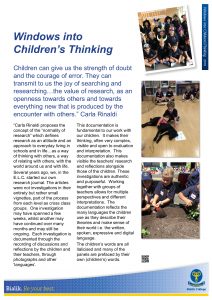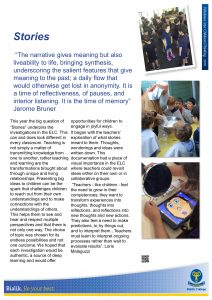Welcome to the
2019 ‘Windows Into Children’s Thinking’ Exhibition
The narrative becomes a form of thought and gives structure and meaning to a story, thus giving it existence, transforming it into a life story, recreating it and giving it new meaning. “There is no life if it is not told,” said Jerome Bruner. “The narrative gives meaning but also liveability to life, bringing synthesis, underscoring the salient features that give meaning to the past; a daily flow that would otherwise get lost in anonymity. It is a time of reflectiveness, of pauses, and interior listening. It is the time of memory”.
The concept of “Stories” became the catalyst for our whole ELC investigation during 2019. This was a collaborative decision made by all educators, which gave them a sense of ownership. Presenting big ideas to children can be the spark that challenges children to reach out from their own understandings and to make connections with the understandings of others. This helps them to see, hear and respect multiple perspectives.
It began with the teachers’ exploration of what “Stories” meant to them. Thoughts, wonderings and ideas were written down. This year, for the first time, we included the parent voice as well. This documentation had a place of visual importance in the ELC where teachers could revisit and reflect on the thoughts and ideas of others. The choice of investigation was chosen for its endless possibilities and not one outcome. We hoped that each investigation would be authentic, a source of deep learning and would offer opportunities for children to engage in joyful ways.
Our professional learning and planning allows a complex and interactive process in which teacher reflection and collaboration is viewed with the utmost importance. Through observation, analysis and reflection the teachers constantly considered why they did what they did. For us research is considered a strategy, a response to curiosity and doubt. The research is part of our everyday practice. It provides the possibility for critical thinking and constructing new knowledge.
In fact, the process is parallel to the way that we see our children learning. Our seminar meetings held weekly give opportunity for teachers to share their documentation with others and to reflect, question and learn from the different perspectives of other teachers in the group. This shared documentation is the foundation for the planning and reflecting that occurs in these meetings.
The investigations taking place in each classroom with the umbrella focus of “Stories” were seen through different lenses. The sciences, mathematics, language and literacy, geography, Jewish Studies and more.
Another first for us this year is the inclusion of our Creche into the Journal. According to Maddalini
Tedeschi an educator from Reggio Emilia “By their very nature, very young children break with tradition…These very small children propose, or we could almost say, they impose a different way of seeing on the adults.”
What follows are not investigations in their entirety, but rather small vignettes, part of the process, from each level. The investigations may have spanned a few weeks, months or even a year and some are still ongoing. Each investigation was documented through the recording of discussions and reflections by the children and their teachers, and through photographs and other languages. “How complex are children’s ways of building knowledge, therefore how complex are the ways of capturing it.” (Reggio Emilia)
Click on the links below to access the classes:
Kinder 3 Aleph Kinder 3 Bet Kinder 3 Gimmel
Kinder 4 Aleph Kinder 4 Bet Kinder 4 Cross Class
Prep Aleph Prep Bet Prep Gimmel Prep Cross Class


